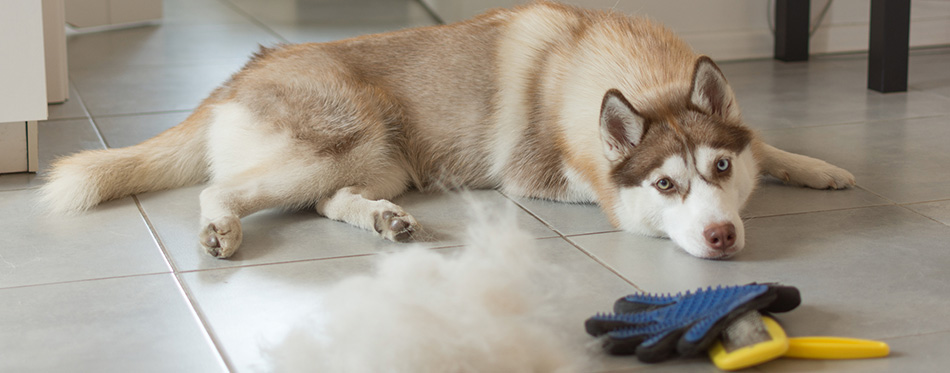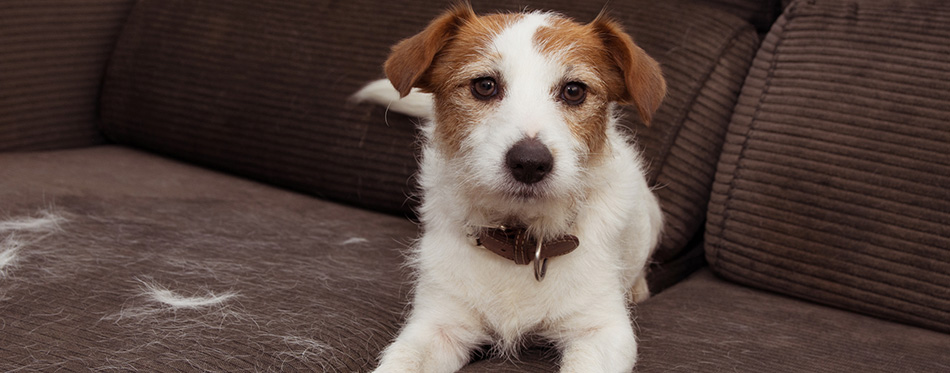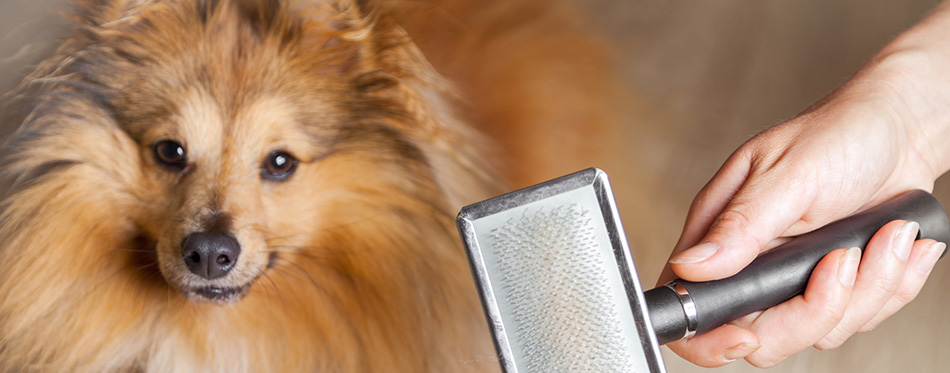Like all furry pets, dogs shed old and damaged hair on a regular basis. Although this is a completely natural process for all dogs, the quantity and frequency of hair that is shed depends on several factors, including the dog’s breed, health, as well as the current season. While perfectly normal for all breeds, shedding can be particularly noticeable if you own a thick-coated pup, such as a Siberian Husky, Akita, Chow Chow, or Newfoundland. If your dog sheds like crazy, don’t fret – there are ways you can minimize the amount of pet hair in your life. Here are 10 of them.
Frequent Brushing
Most veterinarians and groomers recommend brushing your dog every few days, no matter the length of their coat. That said, dogs with thick undercoats may require thorough daily brushing, while those with thinner coats may need only a quick going-over once or twice a week. While the frequency of grooming will depend on the breed of your pet, it’s important to do it regularly and consistently as this is the number one thing that can help reduce the amount of hair that is shed. Here is how to do it properly:
- Choose the right brush: to properly remove old pet hair, it’s essential to choose the right dog brush. Some brushes are designed for general purposes, while others are made for specific issues; for example, there are special dog brushes for super-thick coats and there are regular combs for thinner coats. If you’re planning to use a brush to remove hair mats, it’s recommended you use a universal slicker brush; alternatively, use a different type of brush that’s specifically designed for this purpose.
- Keep it short and fun at first: if the choice is between long and thorough brushing sessions and short and sweet ones, go with the latter, at least in the beginning. It’s important to introduce the brushing sessions in an enjoyable way to your dog as they’ll be getting them their whole life. So, start slowly; keep the sessions short and fun in the beginning and offer treats for good behavior. Gradually increase the length of brushing time as your pup learns to enjoy it.
- Brush the right way: as mentioned, the type of brush you choose is important, but even if you purchase the best grooming brush there is, if you’re doing it wrong, it’s not going to be worth it. Learn about your pet’s breed and the best way to brush their coat. Some types may require more thorough, energetic brushing, while others only need quick going-overs every few days. Never be rough with your dog’s fur though, even when removing mats!
Check out our guides on Dog Flea Combs and Dog Shedding Brushes for more options.

Regular Bathing
Regularly bathing your dog is vital not only for their coat health but for their overall health and wellbeing as well. Bathing your pooch with warm water and gentle shampoo cleanses their coat and skin, helps get rid of odors, and of course, helps remove dead and damaged hair. You can use standard pet shampoos if your pup doesn’t suffer from any skin conditions and generally sheds within the normal range, but you can also get de-shedding shampoos and conditioners for dogs which contain specific ingredients that hydrate the skin and help remove excess hair hiding in the undercoat. If used consistently, these types of shampoos can help create stronger hair follicles, and as a result, minimize shedding.
Whichever shampoo you choose, it’s important that it’s specifically made for pets. Do not use human shampoos as some of the ingredients found in our hygiene products can be irritating to dogs.
Head over to our review of Dry Shampoos for Dogs and Dog Shampoos for more choices.
Healthy, Balanced Diet
Feeding your dog a healthy diet is important for their overall health and well-being, including their skin and coat. A balanced diet, meaning food that contains all vitamins and minerals essential for canine health, will support strong hair follicles and healthy skin. A diet that is lacking in some macro and/or micro-nutrients will, on the other hand, lead to all kinds of problems, including excess shedding. So, invest in a balanced, healthy diet and you and your pup should have no problem with unwanted shedding.
Concentrate on all macro-nutrients, but especially quality fats and protein as these promote overall health and well-being, as well as a strong, shiny coat. While your dog may not need a diet that is very high in protein, it’s more than likely they will benefit from a diet that is higher in healthy fat if they’re shedding excessively. Of course, finding a quality pet food that’s budget-friendly is easier said than done, which is why you may want to consider…
Supplements
Not all dogs need supplements – if you’re feeding your pet a healthy, balanced diet and they’re generally healthy and shed within the normal range, there’s probably no need for supplements. However, if you suspect that your dog may not be getting enough healthy fats through their diet, supplements can be a godsend. Essential fatty acids, specifically omega-3 but sometimes omega-6 too, are highly beneficial for healthy skin and coat. That being said, most dogs already have too much of the omega-6 fatty acids in their diet and way too little of the omega-3 fatty acids, which can create a disbalance and lead to all kinds of health issues, including inflammation and excessive shedding. If your dog’s diet is rich in omega-6 fatty acids (check the Analysis label on the back of the food packaging), we suggest focusing on omega-3’s only.
Fish oils like salmon oil are a fantastic source of omega-3 fatty acids, including DHA and EPA, which are great for your dog’s overall health, and specifically their skin and coat health. Flaxseed oil is also a good choice, and often olive oil and coconut oil can help too. Take a look at our reviews of fish oils for dogs and salmon oil for dogs for more info.
Increase Water Intake
Similarly to humans, many dogs would greatly benefit from increased water intake. Not sure if your dog should drink more water? If they’re drinking less than they should, their skin will suffer and reflect that – it will be dry, rough and flaky. Unsurprisingly, dehydrated skin can be a major cause of unwanted hair loss. Now, knowing exactly how much water your pup is drinking can be tricky, but knowing roughly how much they’re getting can be easy. Generally speaking, all dogs should drink an ounce of water per body weight daily, so measure your dog and calculate exactly how much water you should be providing every day. Then, keep an eye on their water bowl – if they appear like they’re avoiding it, there may be something off with the water or the bowl itself. Many dogs will drink only super-fresh water, so if the water has been sitting in the bowl for more than a day, they won’t touch it. Likewise, if the bowl is really old or damaged or dirty, your dog may not want to drink from it unless absolutely necessary. So, invest in a quality water bowl (stainless steel or ceramic is the best) and keep the water as fresh as possible and your pup is likely to start drinking more every day.

Reduce Stress
Like humans, pets can get stressed out too. In fact, many dogs who suffer from stress in their daily lives also suffer from various health and behavioral issues as a result, including aggression, separation anxiety, and excess hair shedding. It’s actually similar to how we react when under stress – ever noticed how your hair is falling out more than usual when you’re under a lot of stress at work?! Dogs are no different in this manner, but unlike humans who can voice their feelings, meditate or call a friend to complain, dogs have no way to express their frustrations. As a result, they start exhibiting all kinds of unusual behaviors and health problems, including excess drooling, licking, panting, urinating, and yes, shedding.
If you’ve noticed that your pup’s behavior has been a little strange lately, here is what you can do to alleviate their stress levels:
- Daily exercise: walking, jogging, swimming, whatever it is, as long as it’s regular, it’s good.
- Mental stimulation: regular and interactive dog toys are great for this, especially if you spend a lot of time outside the house.
- Calm environment: if your household is super-busy, try giving your dog a couple of hours of privacy in your backyard. If this option is unavailable, getting a cozy dog kennel where your pup can relax is a good idea.
- Lots of cuddles: finally, don’t forget to spend some quality time with your pet on a daily basis. Cuddling, playing or just relaxing together in front of the TV can help alleviate stress and anxiety.
Keep Ticks and Fleas Under Control
If you have an outdoor dog, one of the reasons why they may be shedding too much may be due to fleas or ticks. Of course, indoor pets are not immune to fleas and ticks either, so it’s important to keep an eye on your dog’s scratching habits regardless of where they live. These parasites bite and irritate your dog’s skin, which causes an inflammatory reaction, which in turn can lead to red and itchy skin and excessive hair shedding. In fact, some dogs who are exposed to fleas, ticks and lice for long periods can develop allergies which can lead not only to excessive shedding but full-blown hair loss. You may also like our articles on flea treatment for dogs and flea powders.
To keep your furry companion clean and healthy, it’s crucial to keep these pests under control. This means getting rid of present parasites and preventing them from infesting your dog in the future. Spot-on treatments, oral medications, shampoos, sprays and flea collars are all available, so go with the option(s) that works best for you and your pet. Speaking of parasites, it’s also crucial to treat your dog with medication against heartworms and tapeworms. For a wider selection of choices, check out our heartworm medicine for dogs guide.
Regularly Visit The Vet
This should go without saying, but just in case it’s needed – it’s absolutely vital to take your dog to the vet on a regular basis. Whether your dog is currently healthy (or seems to be) or not, regular vet visits are crucial for canine health and well-being, so never skip a yearly checkup. Certain underlying health conditions which you cannot discover on your own can cause excessive shedding in dogs. If caught in time, they won’t lead to serious health problems, but if left untreated, it’s more than likely they will. For example, some parasitic organisms can leach important nutrients from your pet’s body which are important for their skin and coat health. Likewise, some bacterial and fungal infections can cause excessive shedding. Liver, lung, thyroid and other diseases can also lead to unwanted shedding, and so can cancer. In conclusion? Be proactive and take your pup to the vet regularly.
Vacuum Your Dog
If you’re doing everything right but your dog just naturally sheds a lot, it may be a good idea to vacuum them from time to time. Naturally, not all dogs like to be vacuumed, but most pets can be trained to tolerate it, and some might even enjoy it! The best way to vacuum a dog is to do it after you’ve brushed and bathed them – this will remove excess hair and dander and can keep shedding under control.
A tip: start while they’re young and use a low-noise vacuum. The sooner you start teaching your pooch not to be afraid of the device, the easier it will be for both of you. Of course, some dogs simply hate being vacuumed no matter what. If this is your pet, don’t insist on vacuuming them – just brush them more frequently and…

Vacuum and Protect Your House
Vacuuming your house frequently won’t reduce the amount of hair your pet sheds, but will certainly make your home cleaner and neater. Regularly vacuuming your house will prevent those stubborn stuck-in-the-carpet hairs from forming and will make your living space healthier for both you and your pet. If you’re dealing with a super-shedder, consider getting a special vacuum for pet hair as these machines are specifically designed to get as much hair and dander from the carpets and other surfaces as possible.
Finally, it may be a good idea to purchase a couple of protective products for your house, such as pet furniture covers or dog blankets. Sofa covers in particular can be useful as they help protect your furniture not only from pet hair but dirt and slobber too. Plus, unlike the furniture itself, the covers are easy to wash!

